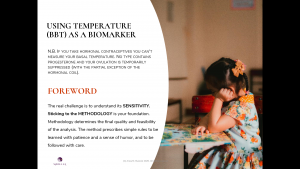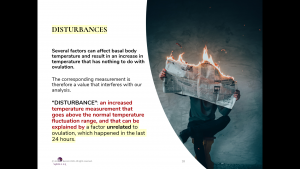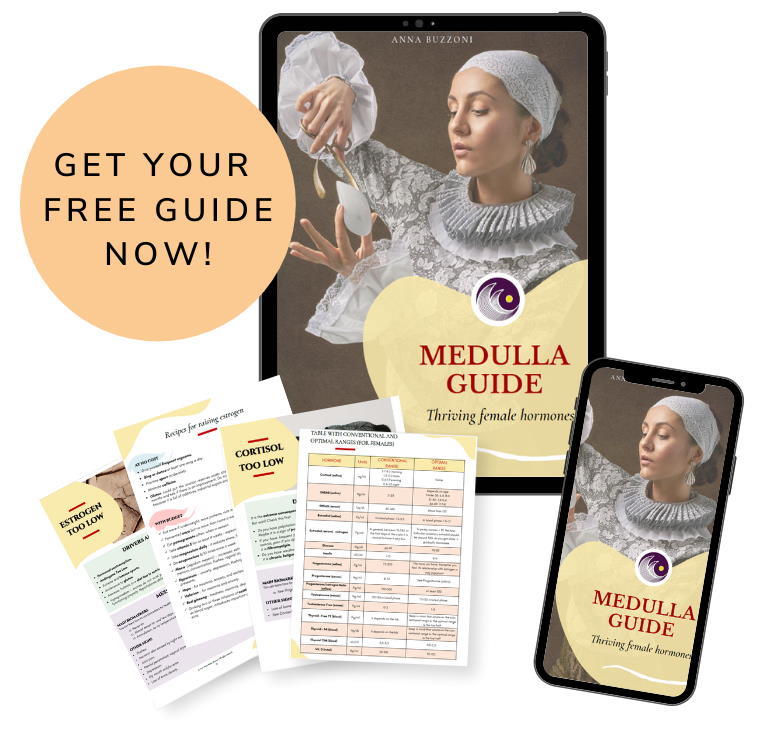Basal body temperature 101 – charting the menstrual cycle
When we chart the menstrual cycle, one of the most frequently asked questions I receive is: Can I determine ovulation based on the observation of cervical mucus? The answer is no, let’s see why.
Ovulation can only be determined once it has occurred, and the biomarker (read: the physiological signal observable by the naked eye) is the rise in basal body temperature, not the observation of cervical mucus. Before getting into the specifics, let us reiterate a key concept: ovulation can never be predicted, therefore, all methods or apps that predict it are deceiving you (if you are trying to avoid a pregnancy, be warned!). The calendar method, the rhythm method, the basal body temperature-only method, the cervical mucus-only method, and all the apps that predict the day of your next ovulation are unreliable and unfortunately the authoritative fertility awareness methods (FAM in English) based on the symptothermal methodology (i.e. mucus+temperature) are not well known.
Ovulation can only be determined once it has occurred, and the biomarker is the rise in basal temperature, not the observation of cervical fluid. However, if it is a child you are looking for, using only basal body temperature is a serious mistake – you need to use mucus to know when to have penetrative intercourse.
What is basal temperature
Basal body temperature (BBT) is the lowest temperature that your body reaches, normally at night, during sleep.
In the first part of the cycle (menstrual and follicular phase) your BBT will have a rather steady and lower value which we will call X. After ovulation and until the next menstruation, your BBT will rise and have a value that we will call X + 1 degree Celsius.
The rise in BBT is actually less than 1 degree Celsius, more often it is 0.5-0.8 degrees Celsius, but here we simplify to be clearer.
Why is basal body temperature important?
BBT tells us if we have had anovulatory cycles (which can cause, if sustained over time, a decrease in bone density, and affect heart and breast health, among other things). It tells us how much stress, sleep and food impact on our body; if we have a progesterone deficiency or a short luteal phase; it will tell you the state of health of our thyroid gland, especially in cases of hypothyroidism. Finally, it reveals the pregnancy about 18 days after fertilization, allowing you and your gynecologist to accurately time your birth date. We will talk about it in detail at the end of the post, stay with us!
Below we see the salient information to start charting it but remember that this information is not for contraceptive purposes. If you want to learn charting as a method of contraception, our founder Anna is a certified teacher of the Sensiplan® method, the most reliable method for natural contraception, with a Pearl Index (the efficacy) of 2% (meaning that only 2 people over 100 will get unintentionally pregnant over one year using the method, compared to 9% of the oral pill).
When, what, where to chart basal body temperature?
When: BBT is measured as soon as you wake up, before getting up, talking, drinking or doing anything else (even cuddling your cat, for example).
What: Make sure you have the thermometer handy on your nightstand. The thermometer should preferably be set for basal temperature (average cost, 15 euros). This means that if it is digital, it will have two decimal places and should be accurate to plus/minus 0.1 °C.
If analog, it will have the numbers well-spaced, and will not exceed 38 degrees °C.
How: In one of the following orifices – mouth (under the tongue, between the frenulum and teeth, mouth closed), vagina or rectum. Once you have chosen one, stay with it for the whole cycle. Try to always place the thermometer in the same position. For example, I always put it in the right part of the mouth, under the tongue. If you use the analog thermometer, take it for 3 minutes. The digital thermometer beeps when it is finished but you ignore it and continue for 3 minutes. BBT should always be taken at the same time to provide a reliable reference. If it is not possible to wake up at the same time (on holiday for example), take note of the different time. If the temperature is higher than your normal fluctuation, put it in brackets and ignore it. Or skip that day and leave the box empty. Box?!? We’ll get to that.
Where: There are several grids to chart the cycle on paper. You can also use an app on the phone if you like (here you can find a table ranking the most reliable apps based on scientific research, but remember to disable the function to predict ovulation). If you want to use pen and paper (the ecological option), you can download and use Medulla’s chart .
Now your expression is more or less like this, isn’t it?

It’s actually a lot simpler than it looks! I also looked at it in horror back in 2013. Within three days I had already realized that it was harmless, and within two cycles I was able to fill all the temperature without having nightmares. But I had a teacher by my side, I didn’t do it all by myself. If you need help, you can book a session online or buy our Basal Body Temperature E-Book for €25 by writing to hello@annabuzzoni.com.






If you want to try it on your own, you are welcome to start by locating the words “Day of the cycle” (the first day of menstrual flow corresponds to day 1) and just below “Date“, where you will put the day of the month (the month and year are at the top). Each day you will mark the corresponding temperature with a dot and then join the dots. Make sure you mark the usual time of your awakening at the top left, and if you wake up at a different time than usual, write it down in the box corresponding to the cycle day/date.
Why is the basal temperature rising?
At ovulation, the follicle containing the ovum ready to be fertilized opens, releasing the ovum, which will be taken from the ovary by the uterine tube and begin its crossing to the uterus (which lasts about a week). For a general review there is this short explanatory video which is very nice.
The follicle is dead, kaputt, but… in less than 24 hours it is reassembled and reprogrammed into an endocrine gland (i.e. that produces and secretes hormones) called the corpus luteum. There is nothing in the human body as extraordinary as the corpus luteum follicle, which in such a short time resurrects, changes identity, and becomes operational. The corpus luteum produces progesterone (the pro-gestation hormone, i.e., necessary to sustain a pregnancy) which speaks to your thyroid gland (another butterfly-shaped gland more or less at neck height) and tells it to raise the temperature of your body.
Soon after ovulation your BBT will gradually increase by about 0.5-0.8 degrees Celsius, although this figure varies from woman to woman. A strong corpus luteum will produce a marked increase. A weaker corpus luteum will produce a smaller rise, but it must be at least 0.2 degrees Celsius. That’s why double decimals, or numerals, are important. We are talking about subtle but perfectly discernible changes with a little practice, a sense of humor, support and patience. Usually it only takes two or three cycles to become a pro, with the support of a certified teacher.
At ovulation, the basal temperature gradually increases by about 0.5-0.8 degrees Celsius, although this figure varies from woman to woman. The minimum increase should be 0.2 degrees Celsius.
The body temperature rises because the corpus luteum builds the nest, in which the fertilized will grow. The nest is naturally our uterus. And it must be warm to be cozy.
This temperature rise must be sustained over time, minimum 10 boxes, maximum 16 boxes. At each cycle, however, the number will always be the same for each of us, for example, for me it is always 13.
BBT can help you identify underlying problems. Let’s see which ones.
The cervical mucus has been super fertile then it disappears, but the temperature is not rising.
If you have observed transparent, elastic mucus and have a wet feeling at your vaginal opening, and after a few days it disappears but the temperature has not increased, you have not ovulated (to better understand what we mean read what your cervical fluid is telling you or watch the videos or write an email to hello@annabuzzoni.com to buy our Cervical Mucus E-book for €25).
Ovulation may be delayed or suppressed because the body is under stress. Sources of stress can be industrial food, little movement, illness, travel, intense sports, diets, psychological trauma, severe mental stress such as exams, deadlines, interviews, etc.
However, the body was already preparing for ovulation, which is why the fertile mucus had appeared. If for some reason ovulation does not occur, the mucus will become opaque, creamy and scarcer, and the temperature will not rise.
What to do? Continue to observe mucus and temperature. You’ll probably ovulate after a few days. Fertile mucus will reoccur, and the temperature will rise. If it never rises, and you end up having your period without BBT ever rising up, you can be certain that you have had an anovulatory cycle.
That is to say, ovulation did not take place, the corpus luteum therefore did not form, and the menstruation you see is not really authentic but is the partial result of your partial cycle: you are eliminating the layers of endometrium that had accumulated during the follicular phase of the cycle. In the presence of frequent anovulatory cycles you should consult your doctor to determine the cause. Anovulatory cycles sustained over time can lead to emotional and cognitive decompensation, and loss of bone density or osteoporosis in old age. Of course, if you don’t ovulate you will also have problems getting pregnant.
The temperature rises but is unstable and does not remain high for 10-16 days, returning to the pre-ovulatory phase values.
The problems here might be:
- a luteal phase defect (the corpus luteum is weak and dies too soon)
- progesterone is weak
- there is too much estrogen
The causes for these three problems, which often travel hand-in-hand, can usually be identified and solved within a few cycles by making changes to your diet and routine. To give you an example: if you lead a stressful life, are on a strict or poor diet, do intense sports, little rest, a lot of caffeine, a lot of tablet PC and mobile phone, hostile environments and conflicting relationships, low self-esteem, etc., your body and your mind are constantly washed with abundant cortisol, the stress hormone.
Cortisol takes precedence over everything, and saves us from the dangers of every day, as well as waking up in the morning with a nice peak. Hooray! Too bad that it is built with the same “bricks” of progesterone, and that it jams progesterone receptors on the surface of the cells, so progesterone cannot get in. In short, cortisol blocks or impairs both the production and reception of progesterone. Result: the temperature is unsteady, or it drops and does not return higher.
If you have never charted your menstrual cycle and suffer from this problem, you are likely to be more familiar with the following symptoms:
- you feel tired but wired
- difficulty sleeping or staying asleep
- anxiety, nervousness
- distraction, poor concentration
- high blood pressure
- high blood sugar
- sugar and carbohydrate cravings
- migraine and headache
- breast pain, especially near or at the time of menstruation
- pain during menstruation
- abundant and dark-coloured menstrual flow
- brown spotting before menstruation
- abdominal swelling
- premenstrual distress or dis-ease
- miscarriages or infertility
What to do? Consult a good nutritionist or naturopath to examine your usual diet and routine, and understand how to best nourish body and mind, to restore balance. The results are usually noticeable after a few cycles, and improve your life 360 degrees, as well as rebalancing the menstrual cycle. In doing so, you ensure vitality, calm and clarity.
The temperature in the pre-ovulatory phase (when it is lower) is often below 36.4 degrees Celsius.
Note: in the vagina and rectum the temperature is always higher than in the mouth. Take this into account. Here we refer to a value of 36.4 degrees Celsius in the mouth, under the tongue, around 7am.
In this case our body is telling us that maybe we have a lazy thyroid, or even that we suffer from hypothyroidism. If you have several of the following symptoms, please consult your doctor with your cycle charts and seek advice:
- dry skin or hair
- hair loss
- weak, flaky nails
- cold hands and feet
- weight gain and difficulty in losing it
- tiredness
- depression, apathy, lack of vitality and interest in the things of life
- heavy menstrual flow
- low libido
- miscarriages or infertility
What to do? You need to get a good endocrinologist to test your thyroid. Ask her what range of values she is referring to (you need a bit of nerve, I know, but with serenity and humility you can ask uncomfortable questions. Remember: this is about your health, not her ego). The range values for the thyroid gland have been updated and often my clients have problems with their doctor, who still refers to the old ones. For example, TSH values were considered acceptable up to 5-6 mIU/L. Now we know that the optimal values are 0.3-2.0 mIU/L (source: Dr Sara Gottfried, The Hormone Cure, Scribner, New York). In addition, you should also test free T3, free T4 and Reverse T3, as some factors can affect TSH, for example, chronic inflammation of the body or intestine.
The basal temperature is an allied sentinel of our equilibrium.
The temperature rises and stays high for more than 16 days.
If the temperature remains high for 16 days or more, congratulations, you are pregnant! Before you sue the Holy Spirit, however, read the following paragraph.
The temperature is unsteady, both before and after ovulation.
Temperature is not always the same, whether in the pre-ovulatory or post-ovulatory phase; this is normal. Provided it varies by a few tenths of a degree. If, on the other hand, yours undergoes great changes, it is possible that the following conditions are occurring:
- you’re not taking it correctly
- the thermometer is old
- you measure it at different times all the time
- you’ve had a bad night
- you’ve had a late dinner or alcohol
- you have an inflammation in progress (sore throat, flu, cold, but also sprained ankle, injury)
- You are intolerant or allergic to a food eaten in the last 48 hours.
- you’re traveling in a different time zone.
- are you under emotional or mental pressure
What to do? If the problem persists once the technical causes (time, position of the thermometer, inflammation and disease) are eliminated, try to keep a diary of everything you do, eat and drink during the day, and try to go three days without eating a given food (the body takes three days to eliminate everything). For example, you have eaten peanuts on Monday, don’t eat them again until Thursday. With a little patience, it will become clear which foods cause inflammation. The most inflammatory foods can be: dairy products made from cow’s milk; sugar, including sugar hidden in packaged foods, as well as fruit juices; gluten; refined vegetable oils; preservatives. The list is incomplete. A good doctor or naturopath can accompany you on this adventure.
Years ago, so did I. I can’t describe to you the feeling I felt once I got rid of food that was harmful to my health. On the contrary, myopic people will understand me: it was like wearing the right glasses after years of obsolete diopters. Good morning world! A new person, bright mental sharpness, new energy and good sleep! Since then, BBT has been helping me to keep the wellbeing of my intestines monitored. If I notice high temperatures, and the only cause can be food, I easily go back to those 3-4 new or unusual foods, and after a couple of weeks of testing, I can generally find the culprit and suspend it for a few months, and then try again and see.
In conclusion
BBT is a real friend, and she’s always happy to tell us what’s going on in our bodies. A sentinel and ally. Charting and interpreting it certainly requires a little patience, humility (because we never stop learning, and because sometimes we need help with interpretation) and a sense of humor (so that it is a source of knowledge and not further stress) but it can largely repay us for the initial effort. Contact Anna if you need help with charting – she is a certified teacher of the symptothermal method Sensiplan®.
Bibliography
Frank-Herrmann P. et al, 2007, Human Reproduction, The effectiveness of a fertility awareness based method to avoid pregnancy in relation to a couple’s sexual behaviour during the fertile time: a prospective longitudinal study, Vol.22, No.5 pp. 1310–1319.
Gottfried S., 2013, The Hormone Cure, Scribner, New York
Kippley J et al., 2003, The Art of Natural Family Planning, CCL
Li D. Et al., 2013, Epidemiologic Reviews, Negative Spinal Bone Mineral Density Changes and Subclinical Ovulatory Disturbances—Prospective Data in Healthy Premenopausal Women With Regular Menstrual Cycles, Vol. 36, No. 1, 137 – 147, Oxford University Press
Manhart M. et al., 2013, Osteopathic Family Physician, Fertility awareness-based methods of family planning: A review of effectiveness for avoiding pregnancy using SORT, Vol. 5, 2–8.
Prior JC, 2014, Journal of Restorative Medicine, Progesterone Within Ovulatory Menstrual Cycles Needed for Cardiovascular Protection: An Evidence-Based Hypothesis, Vol. 3, 85-103.
Singer K, 2004, The garden of your fertility, Avery, New York







